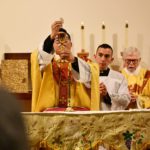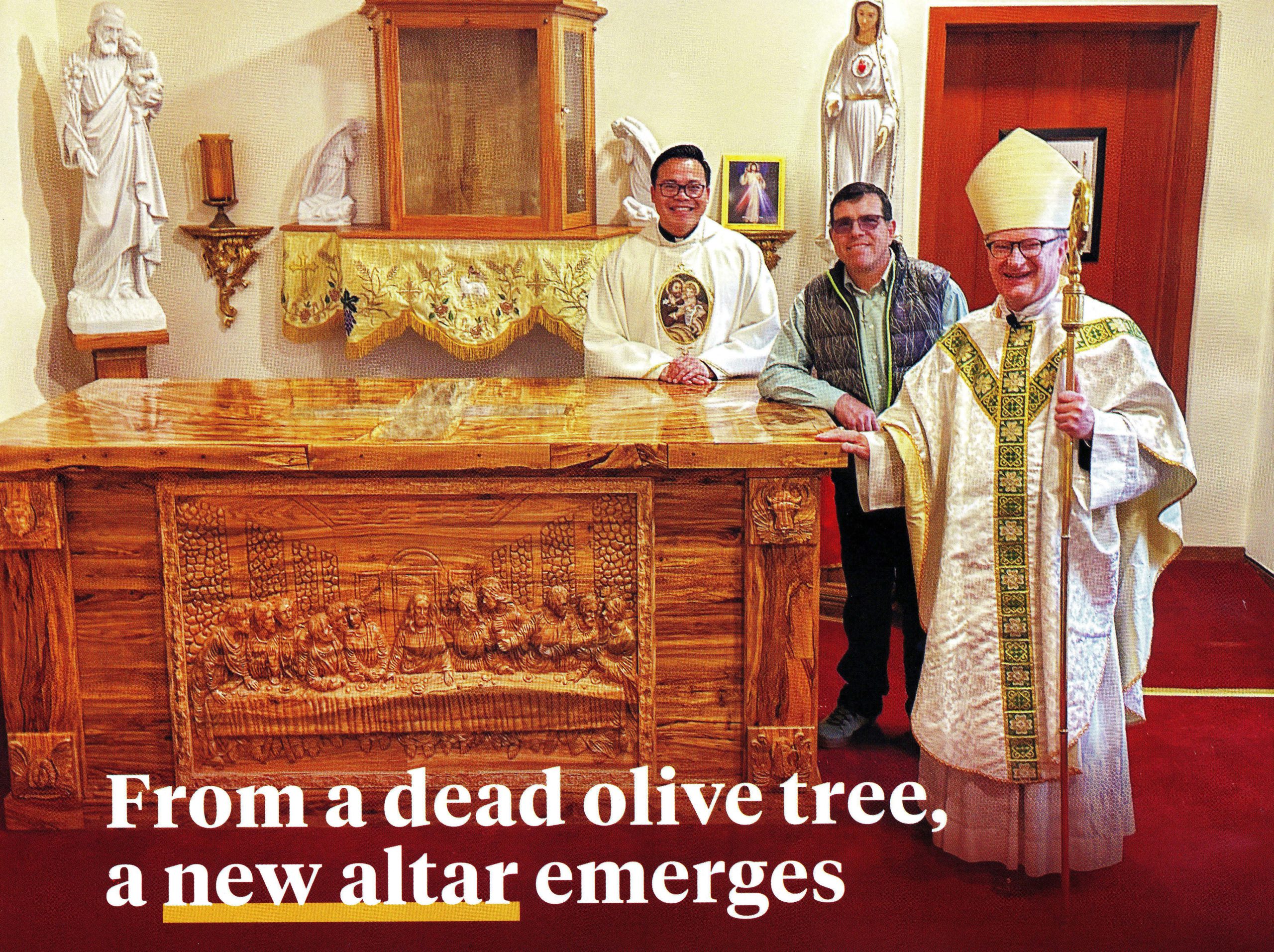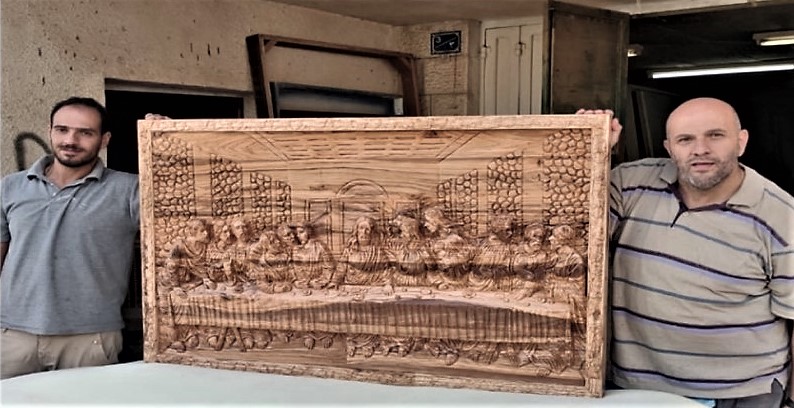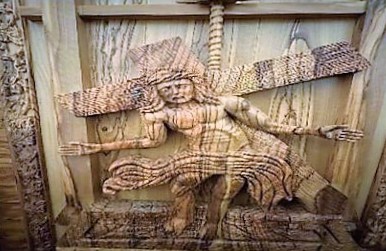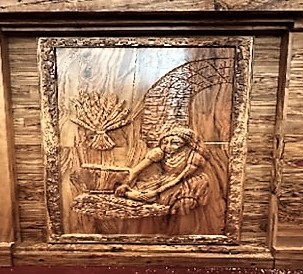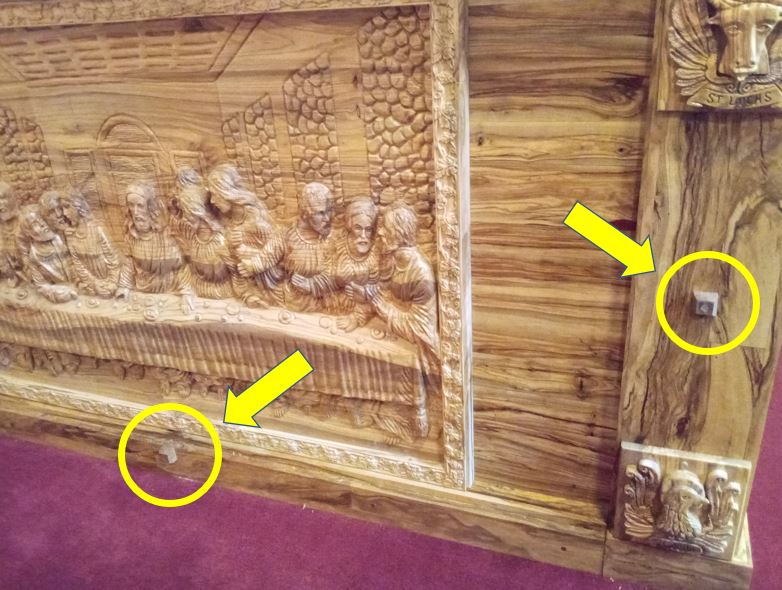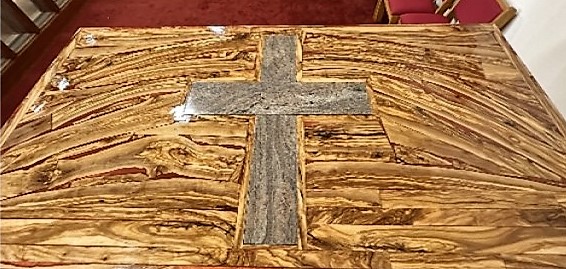Our New Altar
Saint Joseph Parish has a new altar for the upcoming renovated Church. What is an altar? An altar is a table made from stone or solid wood which is dedicated for the sole purpose of celebrating the Holy Eucharist. A dedicated altar represents Christ and His sacrifice. It permanently signifies Christ Jesus, the Living Stone (1 Pt 2:4). In other words, “The altar, on which is effected the Sacrifice of the Cross made present under sacramental signs, is also the table of the Lord to which the People of God is convoked to participate in the Mass, and it is also the center of the thanksgiving that is accomplished through the Eucharist” (Catechism of the Catholic Church, no. 296). Our new altar is temporarily located in the Eucharistic Adoration Chapel. It will replace our existing altar in the main worship space as part of the church renovation project.
Here is the story of our new altar. In 2021 there was a 200-year-old dead olive tree on the Mission Blvd side of our Church, lifeless and decaying. It had been planted by the early missionaries. Our parish campus beautification project has been working to make the material things of our church beautiful so they can proclaim our truth: the beauty and goodness of our God. We want people to feel the presence of God and the mystery of faith when they come here. This inspired giving this old dead olive tree new life as our altar. Paul Qualls, a Fremont resident and fellow Christian, heard about the altar project and offered his expertise. Paul loves to work with wood and felt called to serve God on this project. In June 2021 the 200-year-old tree was cut down by a local tree service (after obtaining a permit from the city since it was an historical tree). Paul oversaw the removal and cutting process.
Just like God, who gives us a second life, this wood will have a second life in the Church. Over the next few months Paul worked with Fernando Nunez, a faithful Catholic serving at St. Catherine of Siena Parish, Martinez. Fernando is a talented carpenter. He treats his wood works as a contribution to God and the mission of the Church. Fernando felt very honored and blessed with this project. Thus, they cut, milled, dried, and treated the olive wood for over a year before cutting it into smaller pieces. In the meantime, Father Anthony reached out to Ann Nguyen, a talented graphic design artist, and they worked together to develop a design for the new altar. The design includes carvings on each side of the altar. These pieces were designed and hand-crafted by wood carvers in Jerusalem from local olive wood. John Qumsiyeh, a long-time parish friend, helped bring these unique olive wood panels here from Jerusalem. What is the meaning of the carvings and symbols on our new altar? The Last Supper: Prominently on the front of the altar is a large depiction of the Last Supper, when the Lord celebrated the last meal with His disciples and established the Sacraments of Holy Orders and Eucharist. This reminds people of the mystery of the Lord giving and feeding His people with His presence in the Blessed Sacrament in the forms of bread and wine. This is the greatest act of love.
The Crushed Christ: This image comes from the 15th-century area depicting Jesus being crushed as he gives his life to satisfy our longing for living water. He is the divine wine that quenches our thirst. His blood was poured out to save humanity from sin and death.
The Indian Woman: According to Andy Galvan, an Ohlone Indian and friend of the Mission, “This is a woman as she would appear during the Mission Period (i.e., 1797-1834). The woman is a Mission Neophyte Indian. During the Mission Period altar bread was made at each Mission, as was the Mass wine from the grapes of the Mission vineyards and the olive oil used for Sacramental purposes from the Mission’s olive trees.” We want to remind all that our Indian brothers and sisters were and continue to be part of the Church. They helped to build and maintain the Mission church for many years. This is to show our unity and communion in Christ.
Four Gospel Symbols: Traditionally the four Gospel writers have been represented by the following symbols: St. Matthew, a divine man; St. Mark, a winged lion; St. Luke, a winged ox; and St. John, a rising eagle. These symbols are taken from the Prophet Ezekiel (1:1-21) and appear on the four front corners of our altar.
Nails: Nails recall that on the altar of the cross, the Lord has been crucified and died for all. They are a reminder of the brutality of sin and death. However, with the Lord’s presence, they are transformed into crowns of glory. There are three raised nail heads on each side of the altar. Three nails in the front represent the nail marks on the cross. All twelve nails represent the 12 tribes of Israel, 12 disciples of Jesus, and the crown of Glory resulting from Jesus’ death.
The Altar’s top: There is a cross in the middle of the altar’s top surface. From the cross, blood-like arrays flow out. This represents that from the altar of the cross, the blood of the Lamb is being poured out for the salvation of all. As we participate in the holy sacrifice of the Mass, we enter communion with the death and resurrection of the Lord. We will be cleansed of our sins and nourished by the very life of Jesus, his body and blood. Underneath the cross, there will be room to insert a relic of a martyr or a saint according to the practice of the church.
Our new altar is a special gift to the community for the mystery which we will celebrate on it. We thank those who help make the inspirational idea a visible and beautiful altar for God and His Church. This altar will be dedicated and blessed as a permanent reminder of Christ’s presence in the Church when the Saint Joseph church’s renovation is done. It will occupy and remain at the center of the sanctuary, toward which the whole community’s attention naturally turns. |
|
|

